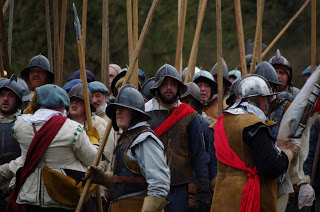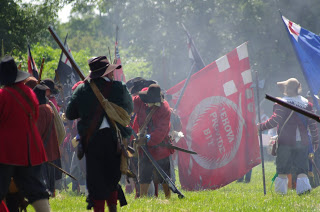London, Part Seven: More Miscellany
Now with added map with locations and travel directions!
A hidden gem - St Mary le Strand's diptych of Charles and Henrietta Maria
The first item of interest, well it probably isn't there, despite so many arguing that it is. The lines of London's fortifications place a large fort in Hyde Park. Earthworks can clearly be seen adjacent to Park Lane near Curzon Gate and it is oft argued that these earthworks are the remains of the fort and the defensive walls erected by Parliament.
The 'earthworks' today
The site of the fort, bottom left; the line of the walls stretching up from the fort
(Rocque's 1746 map)
Sadly, whilst this is clearly the historical location of part of Parliament's defences, these earthworks are most likely to be 'spoil' from the road improvements that took place in the 1960s as pictures from the 1930s clearly show an absence of earthworks.
For a more detailed discussion as to why the mounds in Hyde Park cannot be the remains of the Civil War defences see this investigation.
Moving on from 'are they aren't they' earthworks, the ECWtravelogue travels to Westminster and the mother of all Parliaments.
Well, not actually inside the building itself (that may well feature in a future instalment of the ECW travelogue, once I've worked out how to get inside and see the bits I'd like to see without being arrested or elected), just outside it - Parliament Square.
Located outside the Houses of Parliament is a statue of Old Noll himself. Although he has been obscured by scaffolding recently (they've got the builders in at the moment); at the time of writing he is visible.
 |
| No cheating! All four Cromwell statues feature in ECWtravelogue posts - can you find them? No prizes I'm afraid, just a smug feeling of superiority |
When standing opposite Cromwell's statue, turn 180° so your back is to Cromwell. Above the blocked off back door to St Margaret's Church is a bust of King Charles. The story goes that Cromwell's head is bowed to avoid the gaze of Charles, only there's a problem. Cromwell's statue was erected in 1899, the bust of Charles was only added in 1956 by the Society of King Charles the Martyr.
Sadly photography is not permitted in Westminster Abbey, so please follow the links to see memorials and gravestones inside the Abbey.
Inside you'll find the burial place of Robert Devereux, 3rd Earl of Essex in the Chapel of St John the Baptist. His effigy was destroyed by Royalist troops, a Victorian gravestone marks the spot of his burial. Essex is the only Parliamentarian still buried at the Abbey. At the Restoration all the others were disinterred and reburied in a pit outside the Abbey in the grounds of St Margaret's Church
Memorial Stone to those Parliamentarians disinterred
(It is there, I assure you - it's just hidden behind scaffolding at the moment)
Cromwell's and Ireton's bodies were removed from the Abbey and posthumously executed at Tyburn, their heads placed on a spikes. Marker stones in King Henry VII's/The RAF chapel commemorate their original burial place.
One contemporary tomb remains in the Abbey, although it's inhabitant was removed - that of Edward Popham. The memorial was allowed to stay on condition that the inscription was erased.
Our next item of interest is the church of St Mary le Strand which is located on an island in the middle of the Strand, pretty much opposite Somerset House. The church has a rather fabulous diptych of Charles I and his Queen, Henrietta Maria.
Somerset House was the site of a Tudor Palace, and it was here that Queen Henrietta Maria was able to practice her Catholicism in a private chapel. Parliament sold the contents of the Palace, and used the building as a barracks. It was here that Cromwell's body lay in state.
After the Restoration the Palace went through various phases of renovation and neglect until it was pretty much knocked down in the eighteenth century and rebuilt from the ground up.
Somerset House is now used as a gallery and arts space, guided tours are available - The Old Palace Tour is probably the most appropriate for those interested in all things seventeenth century.
A hop skip and a jump from Somerset House is the Temple, London's legal district. Tucked away on Devereux Court, off Essex Road is the Devereux pub. Built in 1676, the pub was originally a coffee house, and was converted into a pub in the nineteenth century. High up on the frontal façade of the building is a bust of Robert Devereux, the 3rd Earl of Essex.
Our attention now moves south of the river to another former Royal Palace, Greenwich.
The Queen's House, Greenwich was built by James I as a palace for his wife, Anne of Denmark. Designed by Inigo Jones, sadly Anne died before it was completed. The House was completed for Queen Henrietta Maria in 1638. Henrietta Maria turned it into a 'house of delight', but she wasn't to enjoy the property for long. She returned to live in the House in 1660 when her son was restored to the throne.
Open daily, the House is now home to the Royal Greenwich Museum's art collection and one of the most beautiful staircases in the world - the 'tulip' staircase.
Alright, I give in then... For those of you who are gluttons for punishment and fancy shoe horning all these places into a grand day out with an Oyster Card might I suggest the following itinerary; start at Hyde Park, then hop on the tube to Westminster (for the Houses of Parliament, Cromwell statue, Westminster Abbey and St Margaret's); back on the Circle/District line eastbound to Temple (Visit the Devereux first, then a five minute walk to St Mary le Strand and Somerset House); Circle/District line eastbound to Tower Hill for the DLR to Cutty Sark for Maritime Greenwich (and the Queen's House). Just remember to tap in and tap out, otherwise it works out expensive.
Map in the 'correct' order for visiting 👇
St Mary le Strand, Strand WC2R 1ES Temple
Hyde Park, Park Lane W1K 1PN Knightsbridge or Marble Arch
Parliament Square SW1A 0AA Westminster
Westminster Abbey, Dean's Yard SW1P 3PA Westminster
St Margaret's Church, St Margaret Street SW1P 3JX Westminster
The Queens House, Romney Road SE10 9NF Cutty Sark for Maritime Greenwich DLR
If you enjoyed reading this, or any of the other posts, please consider supporting the blog.
Thanks.









.jfif)







Excellent. Great timing too as it will be relatively quiet in the tube now.
ReplyDeleteIt was very quiet on Saturday...
DeleteI've just remembered that about 5 years ago I went to a work conference in Somerset House and we got to tour the lower floor which used to be at river level before the Embankment was built in the 19th century. I think, if I remember correctly, much of that level pre-dated the 18th century build. Wish I'd taken pictures now.
DeleteI hope to add some pictures of Somerset House once everything reopens. Which could be some time
Delete